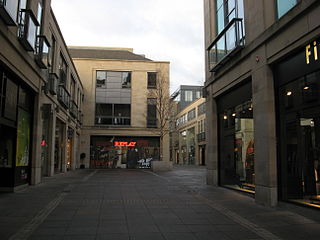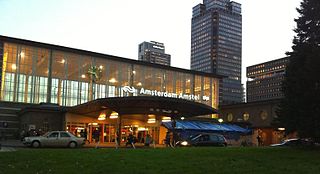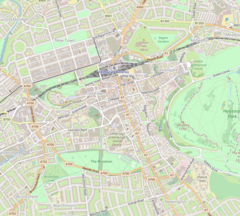
Flinders Street railway station is a railway station on the corner of Flinders and Swanston Streets in Melbourne, Victoria, Australia. It serves the entire metropolitan rail network. Backing onto the city reach of the Yarra River in the heart of the city, the complex covers two whole city blocks and extends from Swanston Street to Queen Street.

Princes Street is one of the major thoroughfares in central Edinburgh, Scotland, and the main shopping street in the capital. It is the southernmost street of Edinburgh's New Town, stretching around 1.2 km from Lothian Road in the west, to Leith Street in the east. The street has few buildings on the south side, and looks over Princes Street Gardens allowing panoramic views of the Old Town, Edinburgh Castle, and the valley between. Most of the street is limited to trams, buses and taxis with only the east end open to all traffic.

Edinburgh Trams is a tramway in Edinburgh, Scotland, operated by Edinburgh Trams Ltd. As of 2017 it is a 14-kilometre (8.7 mi) line between York Place in New Town and Edinburgh Airport, with 16 stops.

Edinburgh Waverley railway station is the principal station serving Edinburgh, the capital city of Scotland. It is the second busiest station in Scotland, after Glasgow Central. It is the northern terminus of the East Coast Main Line, 393 miles 13 chains (632.7 km) from London King's Cross, although some trains operated by London North Eastern Railway continue to other Scottish destinations beyond Edinburgh.

The city of Glasgow, Scotland has a transport system encompassing air, rail, road, and an underground rail line. Prior to 1962, the city was also served by trams.

Haymarket railway station is the second largest railway station in Edinburgh, Scotland, after Waverley railway station.

Lothian Buses is the largest municipal bus company in the United Kingdom. The City of Edinburgh Council owns 91%, Midlothian Council 5%, East Lothian Council 3% and West Lothian Council 1%.

Edinburgh is a major transport hub in east central Scotland and is at the centre of a multi-modal transport network with road, rail and air communications connecting the city with the rest of Scotland and internationally.

Amsterdam Centraal Station is the largest railway station in Amsterdam in North Holland, Netherlands. A major international railway hub, it is used by 192,000 passengers a day, making it the second busiest railway station in the country after Utrecht Centraal and the most visited Rijksmonument of the Netherlands.

Altrincham Interchange is a transport hub in Altrincham, Greater Manchester, England. It consists of a bus station on Stamford New Road, a Northern Trains-operated heavy rail station on the Mid-Cheshire Line, and a light rail stop which forms the terminus of Manchester Metrolink's Altrincham line. The original heavy rail element of the station was opened by the Manchester, South Junction and Altrincham Railway as Altrincham and Bowdon railway station in April 1881, changing to Altrincham railway station in May 1974. The Metrolink element opened in June 1992. The Interchange underwent a complete redevelopment, at a cost of £19 million, starting in mid-July 2013. The new bus station opened officially on 7 December 2014.

Edinburgh, the capital city of Scotland, is a powerhouse of the Scottish economy, as well as the wider UK economy. Edinburgh has been consistently one of the most prosperous parts of the country and has the strongest economy of any city in the UK outside London. Financial Times FDi Magazine has named Edinburgh as the "Best Large European City of the Future" and "Best Foreign Direct Investment Strategy " for 2012/13.

Multrees Walk is a pedestrian shopping area off the east side of St. Andrew Square, Edinburgh, Scotland. Created in 2003 as part of a redevelopment, it links St Andrew Square and St James Shopping Centre and its shops sell luxury goods including clothing, stationery and handbags.

Glasgow Corporation Tramways were formerly one of the largest urban tramway systems in Europe. Over 1000 municipally-owned trams served the city of Glasgow, Scotland with over 100 route miles by 1922. The system closed in 1962 and was the last city tramway in Great Britain.

Amsterdam Amstel is a railway station in Amsterdam, Netherlands. The station opened in 1939. It is located to the southeast of Amsterdam Centraal in the borough of Amsterdam-Oost, near the Amstel river. Amsterdam Amstel is used daily by 50,000 train and metro passengers. Rail services at the station are provided by NS, the principal railway operator in the Netherlands. Metro, tram and city bus services are provided by municipal operator GVB. Regional buses are operated by Connexxion.

St Andrew Square is a city square in Edinburgh, Scotland located at the east end of George Street. The gardens are owned by a number of private owners, managed by Essential Edinburgh and opened to the public in 2008. The construction of St Andrew Square began in 1772, as the first part of the New Town, designed by James Craig. Within six years of its completion St Andrew Square became one of the most desirable and most fashionable residential areas in the city. As the 19th century came to a close, St Andrew Square evolved into the commercial centre of the city.

Between 1901 and 1949 Manchester Corporation Tramways was the municipal operator of electric tram services in Manchester, England. At its peak in 1928, the organisation carried 328 million passengers on 953 trams, via 46 routes, along 292 miles (470 km) of track.
Trams operated in Edinburgh from 1871 to 1956, and resumed in 2014. The first systems were horse-drawn, while cable-haulage appeared in the city in 1888. Electric trams first ran on systems in neighbouring Musselburgh (1904) and Leith (1905), meeting the Edinburgh cable-trams at Joppa and Pilrig respectively. Electrification meant cable trams last ran in 1923, with through running now possible to Leith and as far east as Port Seton. The various systems were operated by different private and municipal entities over the years; the Edinburgh and Leith systems had been merged under Edinburgh Corporation by 1920, but it wasn't until 1928, after the partial closure of Musselburgh line, that all trams operating in Edinburgh were in the sole control of the corporation. The last electric trams ran in 1956, but electric trams returned in 2014 with the opening of Edinburgh Trams. Many of the trams from the horse/cable/first electric era were built in Shrubhill Works. Two trams have been preserved, a horse tram and an electric tram, built by Shrubhill in 1885 and 1948 respectively. A 1903 Dick Kerr cable-tram has also been purchased for preservation. Remnants of the cable-tram system can be seen in Waterloo Place and Henderson Row, and of the Musselburgh line at Morrison's Haven.
Neil Renilson is a businessman who works in the travel and tourism industry. He has held high-ranking positions at a number of large bus companies including Go-Ahead Group, Stagecoach Group and Lothian Buses, and is currently a director of Jacobite Cruises and City Sightseeing.
Various studies, from 1989 onwards, considered the reintroduction of trams to Edinburgh. In 2001, a proposal for a new Edinburgh Trams network envisaged three routes across the city, Lines 1, 2 and 3. Line 1 was a circular route running around the northern suburbs, with the other two forming radial lines running out to Newbridge in the west and to Newcraighall in the south respectively. All lines would run through the city centre.
Essential Edinburgh manage the Edinburgh New Town city centre Business Improvement District (BID). The area covered stretches from Charlotte Square to the new St. James Centre. Their offices are at 139 George Street.
















